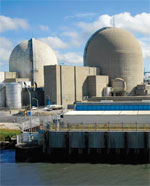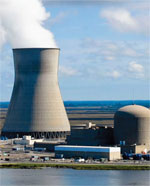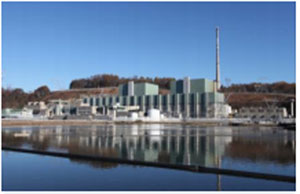PSEG Nuclear LLC
Helping to Keep Electricity Reliable and Affordable
New Jersey’s Salem and Hope Creek nuclear generating stations produce more than 40% of the electricity produced in New Jersey and more than 80% of the state’s air pollution-free generation. The plants, and their more than 1,600 employees, help keep electricity rates affordable, support reliability of the grid and reduce public health costs.
According to a 2020 analysis by the Brattle Group, an economic consulting firm, these nuclear plants save New Jersey consumers more than $400 million a year compared to the alternative sources of electricity and help diversify the state’s power supply. The report concludes that replacing New Jersey’s nuclear plants would add 14 million tons of pollution a year to the state’s air. According to Brattle, this would add $733 million in annual environmental and public health costs.
An analysis by IHS Markit concluded that a reliable, resilient and cost-effective power supply is best achieved by integrating a diverse mix of fuels and technologies. A balanced portfolio of generation resources reduces the risks associated with any one source, including transportation constraints, labor strikes, price volatility, accidents and other low-probability but high-impact incidents.
Important Emergency Instructions
-
PSEG Nuclear operates the Salem and Hope Creek Nuclear Generating Stations in Lower Alloways Creek, NJ and is a part owner of the Peach Bottom Nuclear generation station in Delta, PA.
The Salem Nuclear Generating Station
Operated by PSEG Nuclear, Salem is located along with Hope Creek Generating Station on a 740 acre site in Salem County, New Jersey. Together, the plants comprise the third largest nuclear generating facility in the United States:
- Generates about 40% of New Jersey’s electricity, enough to power three million homes.
- Produces 85% of the state’s carbon-free electricity
- Largest employer in Salem County with over 1,600 employees.
Salem Technical Information
- Dual unit pressurized water reactors (PWR)
- Total generating capacity of 2,285 megawatts (MW), PSEG portion 1,311 MW
- Generates enough electricity to power approximately two million homes each day
- Construction began in 1968
- Unit 1 began commercial service in 1977
- license has been renewed until 2036
- Unit 2 began commercial service in 1981
- license has been renewed until 2040
- Each unit is on an 18 month refueling cycle – each reactor core consists of 193 nuclear fuel assemblies.
- PSEG owns 57% of Salem, Constellation Energy Generation, LLC (Constellation) owns the remaining 43%.
Hope Creek Nuclear Generating Station
Operated by PSEG Nuclear, Hope Creek is located along with Salem Generating Station on a 740 acre site in Salem County, New Jersey. Together, the plants comprise the second largest nuclear generating facility in the United States:
- Generates about 40% of New Jersey’s electricity, enough to power three million homes.
- Produces 85% of the state’s carbon-free electricity.
- Largest employer in Salem County with over 1,600 employees.
Hope Creek Technical Information
- Single unit boiling water reactor (BWR)
- Total generating capacity of 1,172 megawatts net – extended power uprate in 2008
- Generates enough electricity to power approximately one million homes each day
- Construction began in 1974 with commercial service beginning in 1986
- License renewed until 2046
- Unit is on an 24 month refueling cycle with reactor core consisting of 764 nuclear fuel assemblies
- PSEG owns 100% of Hope Creek
Peach Bottom Nuclear Generating Station
Peach Bottom Technical Information
- Dual unit boiling water reactor (BWR)
- Total generating capacity of 2,549 megawatts (MW),
PSEG portion 1,275 MW- Generates enough electricity to power approximately
2.7 million homes each day- Commercial service beginning in 1974
- License renewed until 2033 (Unit 2) and 2034 (Unit 3)
- PSEG owns 50% of Peach Bottom, Constellation Energy Generation, LLC (Constellation) owns the other 50%.
-
Ionizing Radiation: What you should know about it
The radiation given off by the radioactive materials in commercial nuclear power plants is called ionizing radiation. That means that it causes ion pairs (positively and negatively charged particles) to form in the cells that the radiation encounters. It is important to understand that ionizing radiation from nuclear power plants is the same as ionizing radiation from other possible sources, such as cosmic radiation, medical treatments and the naturally occurring background radiation from the soil and building materials around us.
Low-level ionizing radiation is measured in units called millirem (1/1000 of a REM). Most people in the U.S. receive about 250-300 millirem per year from natural background radiation.
The sun and stars give off radiation called cosmic radiation and most of us receive about 27 millirem a year from this source. We get another 28 millirem from the naturally occurring radioactive materials in building materials (usually bricks, stone and mortar) and the soil. There is an additional 200 millirem from the air we breathe, largely from radon.
Radiation exposure is also received from beneficial procedures such as medical treatments and examinations. A chest X-ray is generally about 10 millirem and 9 millirem for a dental x-ray. Most scientists agree that these levels do not have an impact on a person’s health.
In comparison, a person living near a nuclear power plant receives 0.01 millirem per year on average, or one thousand years to equal one chest x-ray (Ref. www.nrc.gov).
-
Sponsorships
- ARC of Salem County
- Bridgeton High School Award Sponsorship
- Rowan University
- Salem Co. Vo-Tech High School Foundation
- Salem Community College Scholarships
- Salem High School Award Sponsorship
- Salem County Chamber of Commerce
- Salem Main Street Program
Employee Community Support- Junior Achievement of Delaware
- Island Charities – Employee Driven Mast/IBEW
- Open Your Heart To a Child Foster Care Program
- Food Pantries & Soup Kitchens
- Salem Co. Red Cross Blood Drives
-
In an effort of unprecedented scale, we began working in 1994 to restore and preserve portions of the Delaware Estuary in both New Jersey and Delaware. Since then, we have restored, enhanced, and/or preserved more than 20,000 acres of salt marsh and adjacent uplands to vital, healthy habitat for fish and wildlife. Learn more
-
PSEG Nuclear works closely with the states of New Jersey and Delaware to protect the health and safety of the public. We have employees ready 24 hours a day, seven days a week to provide emergency support that may be needed. For more information, visit the U.S. Nuclear Regulatory Commission web page. This page provides information on how the public should prepare for, and react to, a radiological emergency. It discusses:
- evacuation and sheltering
- emergency classification
- federal, state and local responsibilities during a radiological emergency
- nuclear plants' response to terrorism
- emergency exercises
- the use of potassium iodide
- research and test reactor preparedness.
-
An exciting learning center focused on building a greater understanding of energy, environmental challenges and strategies for balancing energy demand with environmental stewardship. Learn more
-
Zero Emissions Credits (ZEC) Applications - Second Period (June 1, 2022 to May 31, 2025)























